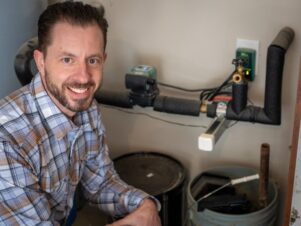
The first installment of the Hydronics CSI was won by Nathan White, Whites Plumbing & Heating, Kenai, AK. His well-thought, concise answer earned him a Lochinvar Jacket. Congratulations to Nathan. Please stay tuned for more Hydronics CSI opportunities.
The Flaw:

Nathan White’s response:
First let’s use a Knight Mod con boiler for this application where we can take advantage of the low return water temp, modulation , outdoor rest features for a high efficiency package. But since it is a solution boiler here’s what needs changed. 1) need closely spaced tees (the ones in the picture are incorrect as you need min 10 pipe dia of straight pipe from each branch and a maximum of 4 pipe dia between the branches) or use my personal favorite a Caleffi Sep4 hydro separator to hydraulically decouple the two circulators, eliminate air, dirt and magnetic particles. 2)The solution boiler with its copper fin construction needs a Low temperature bypass valve in constant low temperature application. This valve would be placed before the suction side of the boiler pump which need to have a(3) integral check or a check valve on the discharge side of it. (4) if not using the Caleffi Sep4 then you will need a Y strainer as well on the return side of the boiler to protect the heat exchanger. (5) The air separator could be removed from the system if a Caleffi Sep4 was used. (6) A system sensor also needs to be hooked up when the solution is ran in a low temp application with the LBV. (7) lets put some valve in this design Paul for the poor guy that has to service it in the future doesn’t have to drain the world to replace a pump. So iso valves on both sides of each pump and ball valves with purge drains on the other lines as a bare minimum to make for easy filling and purging of the system. (8) The boiler pressure relief valve needs to be turned down toward the floor.
The Correction:

The Answer:
1) The closely spaced tee’s separating the boiler loop from the secondary loop do not isolate the differential pressure from the boiler pump. In short, the boiler pump was in series with the zone pump.
2) The boiler is a non-condensing boiler and the (typical) low-return water temperatures from the radiant floor heat would cause the boiler to condense. Sustained flue gas condensation would over-time cause the heat-exchanger in the boiler to fail and the vent could degrade and allow CO to fill the structure. The LTV (Low Temp Valve) will ensure the water temperature entering the boiler will be 140°F or higher.
3) The boiler will produce temperatures above that of low temperature radiant floor heat requirements. The use of a 3rd party mixing valve to provide outdoor reset will allow the proper mixing. (One of several methods of OD reset mixing)




Join the conversation: